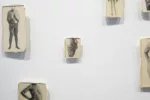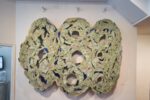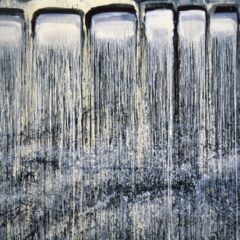The exhibit In Scale of real-world-scale works by 10 artists at The Print Center lends itself to exploring the charms and surprises of the ordinary, just by virtue of scale.
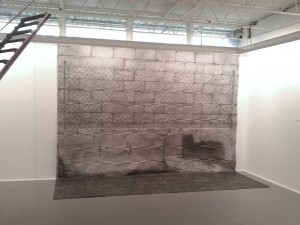
The most surprising piece was a mega-drawing by Gary Kachadourian, Jersey Barrier with Fencing, Asphalt, and Cinder Blocks, 2011. The title is a deadpan description of the content embellished by a sort of accretion of layers of urban soot. I began to think of it as the negative of a Mark Bradford, wordless and unscraped in a completely flat medium. Made of a number of scale drawings processed into a single large-format xerographic print, at 144 x 168 inches, the print is its own kind of fence and barrier, blocking our view of the wall with the ordinariness of urban dismal-tude. The asphalt section slumps across the floor, the usually trod-on surface of asphalt becoming still another barrier that prevents you from bellying up to the work. Curator John Caperton mentioned to me that the artist treats the works casually, folding them up into small squares–a nice pairing of the work’s internal argument between what is precious and in need of protection and vice versa. The method, combined with the content, emphasizes the lack of perspective and further emphasizes the barrier quality and the schematic quality. The grisaille work stole my heart with its scrubby insistence on telling the truth and redefining the experience.
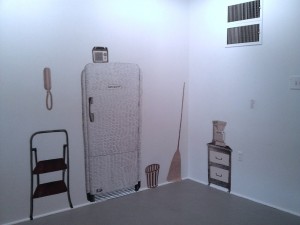
In contrast, Kay Healy’s installation of in-scale screenprints of household objects wheatpasted to the walls have a surprising poetry and humor in their truth-telling. No way are these works recreating an experience. Rather they are story-book diaristic drawings of life experienced in the past. The flattened refrigerator seemed the most paradigmatic, a reminder of taste and design shifts as kitchen fashion has morphed from hearth-like hominess to high-tech efficiency–illustrated in an extremely low-tech medium. Each print expresses personal affections and connections–like Kim’s Armchair, Leroy’s Cathedral Radio, Frank’s Clawfoot Tub. Best of all to me was the wheatpaste decision. Just think. A rough and tumble tradition of street-art making domesticated by subject: you can wheatpaste one of these to your wall at home. You don’t even have to buy a frame. Candle is only $20. And the highest-priced item, Frank’s Piano, is $900. With the reference to wallpaper, and the funny way the installation embraced–and didn’t embrace–me, I found myself puzzled and amused by the 2-D pancaking of our lives. The work raises questions on why we accept on a regular basis a painting or any 2-D work on paper.
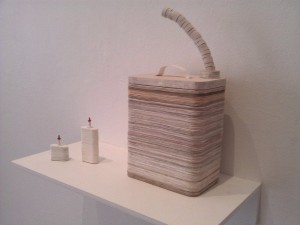
Some of the works were familiar to me–Shelley Spector’s Fossil Fuels, Taylor McKimens’ potted plant sculptures (courtesy of Cereal Art), and Talia Greene’s ant trail. Not familiar at all–Jenn Figg’s fallen tree, which mines the internet for tree bark patterns. While the tree and the trap are literal, even with the use of bark patterns lifted from the internet, the rolled up corrugation inside was materially satisfying as was the enormous scale, a reminder of nature’s scale vs. gallery scale.
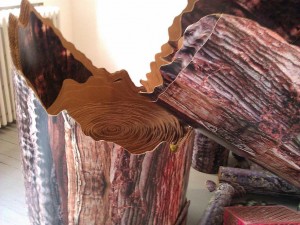
Others in the show–Nichola Kinch, Joseph Lupo and Roy McMakin–and Caitlin Perkins. I deeply loved her Recording Barometer, 2011, with a facsimile barometer she made to scale (part of the installation) and a display of faux barometer readings on facsimile barometer paper marked with juicy gestural lithograph/monoprints. Perkins’ images are palimpsests of two different languages, decoding the world in different ways. The top layers have the look of crayon-colored scribbles and the promise of language–inscrutable like barometer readings, yet familiar. The charting of a phenomenon mainly experienced through scientific scratchings, at least to me, gives meaning to the otherwise elusive Cy Twombly-esque markings on the paper.
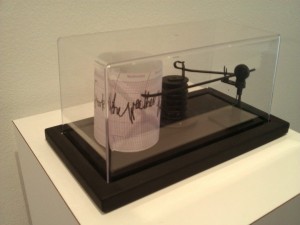
There’s lots to like here, but working to scale creates problems for some of the artists, the ones who haven’t quite figured out how to transform reality and rise above the quotidian.
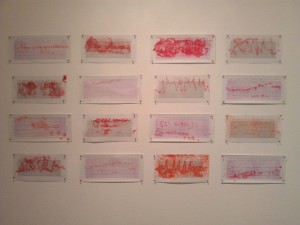
The exhibit runs to Nov. 19.


